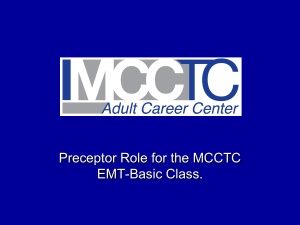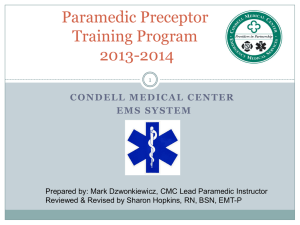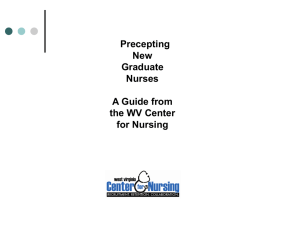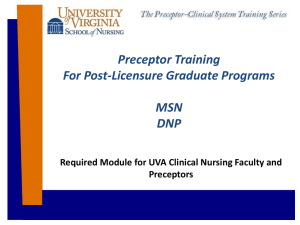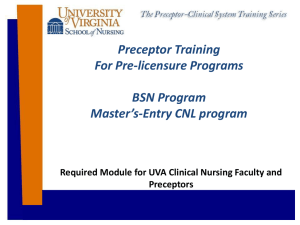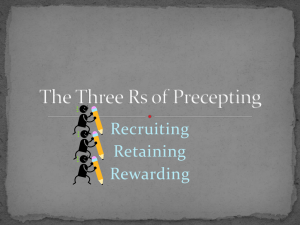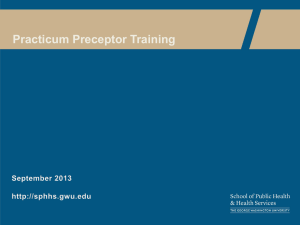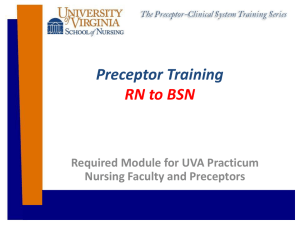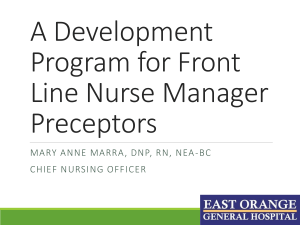Field Internship Preceptor Orientation Program
advertisement
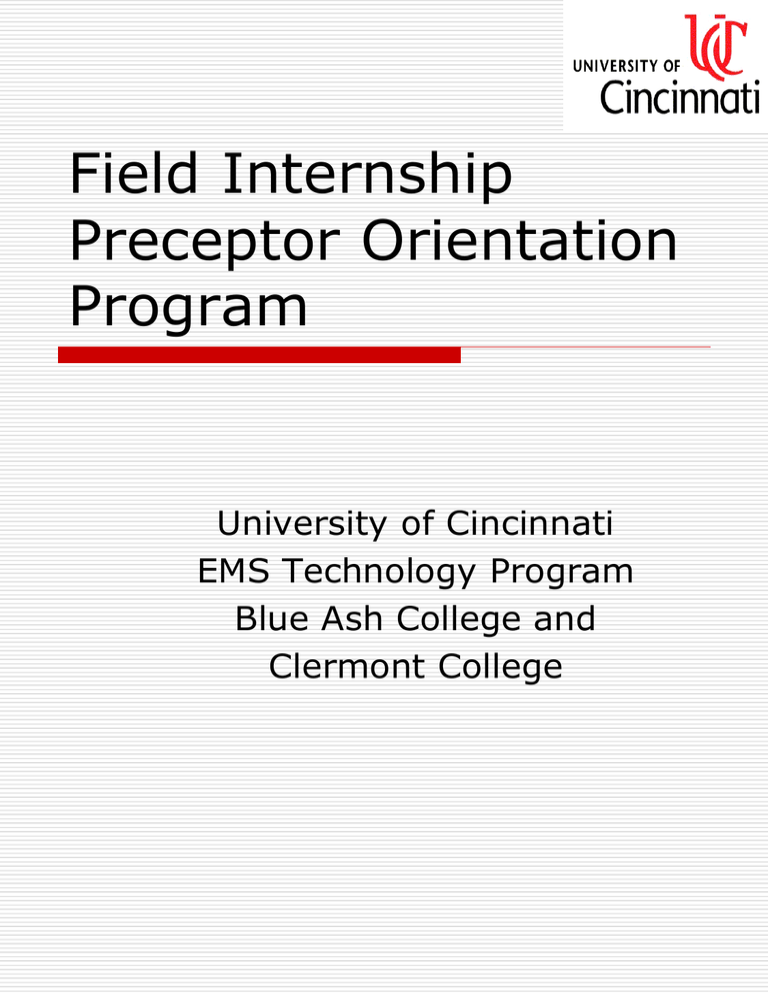
Field Internship Preceptor Orientation Program University of Cincinnati EMS Technology Program Blue Ash College and Clermont College Program Objectives Explain purpose of Field Internship Preceptor Orientation Program Identify Delegate, School, Student, and Preceptor responsibilities Describe the three (3) phases of the “Field Internship” Describe the characteristics of the field preceptor Program Objectives Define and give examples of “Positive/Correctional and Positive Reinforcement Feedback” Identify tools used to evaluate the paramedic student Describe problems that the preceptor may encounter and the steps that are taken to rectify specific problems Purpose of Field Internship Preceptor Orientation Program To give the field internship preceptor the opportunity to gain insight into the expectations of what is needed to successfully precept a University of Cincinnati paramedic student Allow the preceptor the opportunity to ask questions he/she may have regarding the program Delegate Responsibilities The delegate is the liaison between the University of Cincinnati and the EMS Unit. He/She is responsible for assigning the student to an approved preceptor Makes sure that each preceptor has viewed the this program, evaluated the program and filled out a data form that is filed with the EMS Technology Program School Responsibilities Assure that the student is prepared for the field internship by observing success: Didactically In the lab In the hospital Will constantly reassess the student using feedback from the preceptor School Responsibilities Faculty will be available to discuss issues that may arise during the field internship Faculty will remediate students who have been identified by the preceptor as having difficulties Paramedic Student Responsibilities Schedule ride time with the EMS Unit as prescribed Arrive at least ten (10) minutes before the start of the shift Be properly dressed according to policies and procedures Wearing his/her University of Cincinnati “Paramedic Student” ID badge Paramedic Student Responsibilities Reviews paperwork with the preceptor Informs the preceptor which phase the student is in Accepts the preceptors critiques with an open mind Acts in a professional manner at all times Reviews all end of shift paperwork with the preceptor Preceptor Responsibilities Ensures that the student is given the opportunity to receive the best educational experience possible Possess good communication skills Provides positive and correctional feedback when necessary Supervises field performance of the student Preceptor Responsibilities Reviews and signs paperwork at the end of the shift Evaluates the student and documents strengths and areas that need improvement Reports any problems or concerns to the delegate or directly to UC EMS faculty Three Phases of Field Internship Phase One (1) First ten (10) ALS runs Student focuses on manipulative skills and patient assessment Task oriented For example, assigned to manage the airway or start the IV Encouraged to participate in the assessment Three Phases of Field Internship Phase Two (2) ALS runs #11-20 (or earlier) Student begins to assimilate patient assessment, diagnostic and treatment skills and information to make decisions as a team leader. The student will team lead on simple, straight forward runs such as single system trauma, abdominal pain, etc. Students may need more time in this phase Three Phases of Field Internship Phase Three (3) Final runs #21-32 (or more) The student is asked to function as team leader on all ALS runs As always this is under the direct auspices of the preceptor Focus on decision making, delegation, communication with EMS and ancillary personnel The Successful Preceptor Traits Roles Providing Feedback Problem Resolution Evaluation of Student The Successful Preceptor Traits Honest Patient Good Communication Skills (Listening) Provides positive and correctional feedback Wants to do it Acknowledges there are different ways to achieve the same goal The Successful Preceptor Roles Coach Encourages and teaches while educating Guide Allows the student to make decisions on their own, while offering insight Patient Advocate Patient care and safety is paramount Student Advocate Ensures the student gains the best experience possible The Successful Preceptor Start At the beginning of each shift Review with the student how much field time they have completed Go over the phase they are in Student perceptions of strength and areas for improvement Skills they are allowed to perform Preceptor/Student expectations Tour quarters / check out equipment The Successful Preceptor Feedback Feedback is given as soon as possible after a run It must be private All feedback is given one-onone Whether correctional or complimentary it must not be shared unless the student wants it to be Federal Law Prohibits sharing of student data unless it is within the scope of instruction or evaluation, i.e. faculty or supervisor The Successful Preceptor Feedback Two (2) Types Positive / Correctional and Positive Reinforcement The Successful Preceptor Feedback Positive / Correctional Correctional feedback given in a positive manner Identifies areas of performance that require improvement or an area in which the student must change behavior For example: Reminding a student of the importance of auscultating lung sounds immediately after placement of an ET tube The Successful Preceptor Feedback Positive Reinforcement Encourages desired behavior Helps build self-confidence For example: “Your calm and confident behavior really helped to relax the patient. You did a very good job.” The Successful Preceptor Feedback Be Direct Always direct at the person for whom the correction is intended Objective Ensure feedback is conducted without bias toward race, gender, ethnic origin, sexual preference or creed The Successful Preceptor Feedback Be Clear Does the student understand what you said or meant to say? Be Specific Feedback should not be general goals for improvement, but rather direct actions that the student can take to improve patient care The Successful Preceptor Feedback After the Run Ask the student what they think went well with the run Add positive reinforcement for the good things Ask what they think they could do to improve their care of the patient Provide Positive / Correctional feedback Always begin with the positive! Student Evaluation During the Run Allow the student to complete an assessment before interjecting additional questions that need to be ascertained for a complete assessment (unless this would jeopardize patient care) While the student is performing skills Give advice as necessary so as to not compromise patient care and encourage success with a skill Student Evaluation Field Evaluation / Skills Tabulation Form At the end of the shift the student will approach you to fill out his/her evaluation form The Skills Tabulation should be filled out and completed by the student. Please confirm that the information is correct Please rate the student on a 1 – 5 scale Professionalism / Attitude Phase / Shift Objectives Psychomotor skills University of Cincinnati Paramedic Program Field Evaluation / Skills Tabulation Form Name: Preceptor: Patient ALS Unit: Time: Age Gender ALS BLS Date: #BLS Runs #Hours: Team Lead Chief Complaint ET Success Other ALS Airway Other C/O Field Diagnosis Patient Interview #ALS Runs Physical Exam Vital Sign Telemetry 1 2 3 4 5 6 Patient O2 Device BLS Airway ET Attempt Ventilation ET or BVM EKG 3 or 12 Lead EKG Interpretation Pace/Defib Cardiovert Blood Glucose Pulse Ox Other Skills 1 2 3 4 5 6 Patient IV Attempt IV Success IO Attempt IO Success Medication Route Dose # of times given 1 2 3 4 5 6 Unsatisfactory Requires Assistance Needs More Training Tentative Needs Guidance Competent Minimal Prompting Entry Level EMT-P Good No Prompting Excellent Experienced Level EMT-P 1 2 3 4 5 Student Rates Preceptor Self Rates Student Area of Performance Professionalism/Attitude: The student’s behavior demonstrated integrity, empathy, self-motivation, self-confidence, team work, diplomacy, respect, patient advocacy, careful delivery of service, appropriate time management, appropriate appearance and personal hygiene. Reported to work on time and in full uniform (with UC badge) PRECEPTOR COMMENT: Phase/Shift Objectives: Reviews current objectives and performs the tasks to the standard outlined. Requests and accepts constructive criticism, takes personal responsibility for self-improvement. PRECEPTOR COMMENT: Psychomotor skills: Student can thoroughly describe all elements of applicable procedures and accomplishes psychomotor skills independently and proficiently. PRECEPTOR COMMENT: I verify these skills were performed and have reviewed each run with the student: Student’s Strengths: Student’s Weaknesses / Plan for Improvement: Preceptors Signature: Yes No Date Signed: For questions or comments, please call Raymond Walters College (513) 936-7130 or Clermont College (513 732-5270) Student Evaluation Team Leader Form If the student was performing as the team leader Fill out the Team Lead Evaluation Form located on the back of the student run form Using a 1 – 5 scale the student is assessed on Interview, Exam, Treatment, Skill, and Leadership What are the patients’ potential problems (Differential Diagnosis)? What do you think was wrong (diagnosis) with this patient? Is there anything you would have done differently if you were the lead paramedic? Team Lead Evaluation Unsatisfactory Competent Tentative Good Excellent Requires Assistance Minimal Prompting Needs Guidance No Prompting Experienced Level EMT-P Needs More Training Entry Level EMT-P 1 2 3 4 5 COMPLETE THIS BOX EACH TIME YOU WOULD LIKE CREDIT FOR HAVING ACTED AS A TEAM LEADER. Skills Interview: Exam: Treatment: Skill: Leadership: SE 1 2 Completed comprehensive interview. Demonstrated active listening. Completed an appropriate head-to-toe and/or focused physical exam. Formulated a field impression and implemented treatment plan. Interventions performed were complete, satisfactory and timely. Set priorities, directed team, and adapted to evolving information. Student successfully led the EMS team during this patient encounter. Comments: Yes No Preceptor Signature: Date Signed: MONITOR STRIP Rate: Rhythm: Interpretation: PR Interval: QRS: QT Interval: 3 4 5 Problem Solving (1) Student arrives at the station dressed inappropriately and without the UC ID badge Dismiss the student from the rotation and tell him/her to call their instructor Notify Tony Kramer (513) 936-7130 Problem Solving (2) After giving positive / correctional feedback to a student regarding IV insertion technique the student tells you, “I have been starting IV’s for two years, I know what I did wrong!” Keep calm, the student may be embarrassed about the IV miss Be positive, letting him know you understand he has experience, but that you observed something that could help him You can’t force students to accept your help, but you should notify the faculty about the situation Problem Solving (3) Student comes in late on more than one occasion and always has some excuse as to why they are late. Explain to the student that you are waiting for them and their tardiness puts you behind Inform your EMS officer about the situation The EMS officer should notify the clinical coordinator (Tony Kramer 513-936-7130) Problem Solving (4) “The student does not get it!” The student may be rough, make inappropriate comments, or is just extremely nervous. Give the student task oriented assignments, i.e. “take the B/P”, or “just focus on the IV.” If they still cannot focus give them encouragement and call the clinical coordinator. Problem Solving (5) You are tired and need a break from precepting. There is nothing wrong with admitting that you may not be in the right frame of mind to give the student the best educational opportunity. Notify your EMS officer and see if the student could be placed with a different preceptor Thank you! The students and faculty at the University of Cincinnati EMS Technology Program deeply appreciate your commitment to the education of our paramedic students If you have any questions or comments, please don’t hesitate to contact Janice Evans, Program Director @ 513-936-7132 University of Cincinnati EMS Technology Program Clermont College Jeff Waldenmayer 513-732-5270 Blue Ash College Janice Evans 513-936-7132 Cincinnati/Northern Ky. International Airport FD Tony Kramer 513-936-7130
